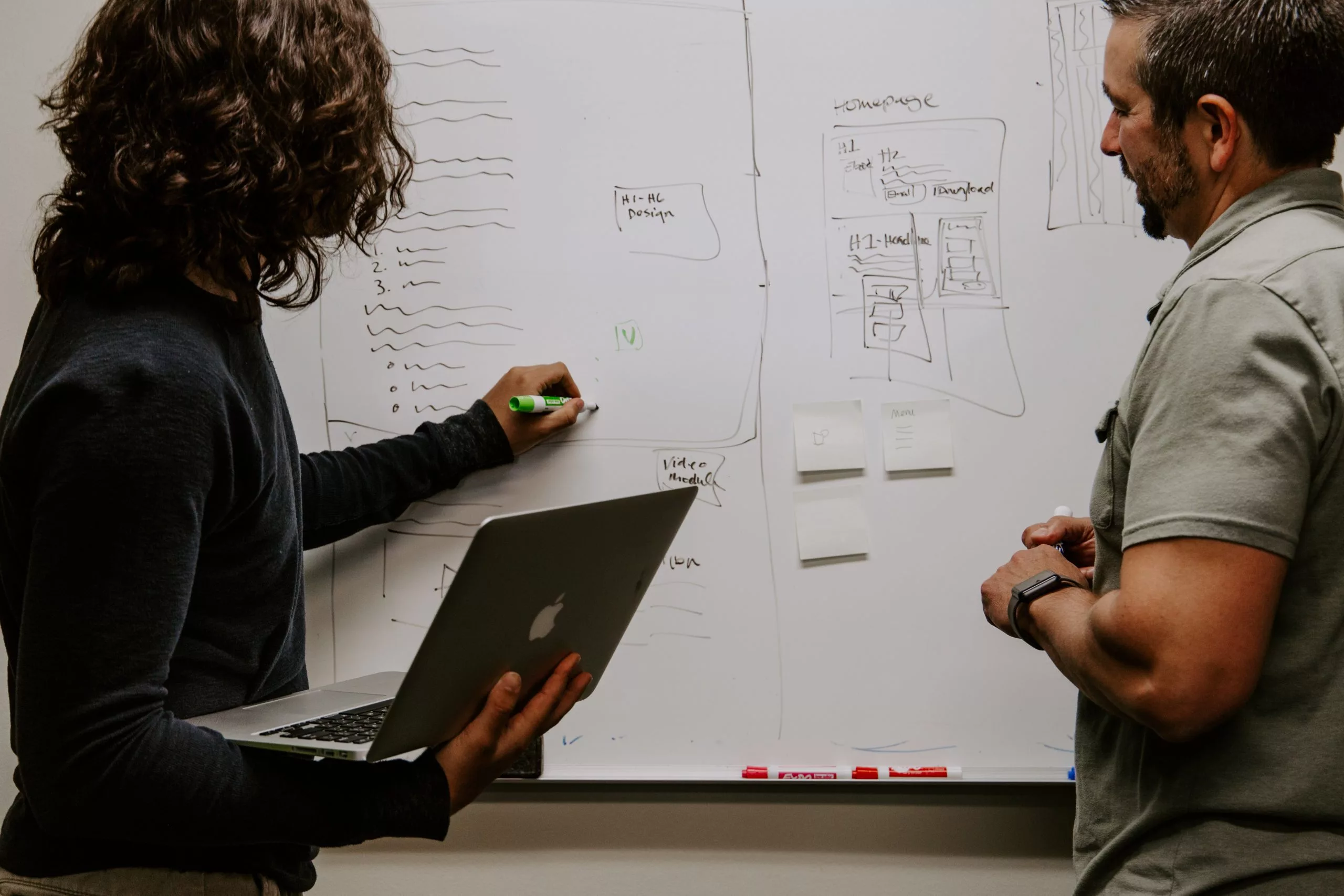Companies are constantly seeking new ideas and innovative solutions to stay ahead.
Brainstorming is a powerful technique that can help organizations tap into their teams’ collective creativity. We hear this from customers who regularly use our training course materials.
This guide aims to provide a comprehensive overview of brainstorming, its importance for companies, various methods of brainstorming, best practices, a step-by-step model, differences between brainstorming and facilitation, examples of brainstorming in the workplace, and the benefits of brainstorming in corporate marketing settings.
Definition and Background
Brainstorming is a collaborative problem-solving technique that encourages individuals or groups to generate a large number of ideas in a short period. It was first introduced by Alex Osborn in the 1940s to stimulate creative thinking. The primary goal of brainstorming is to foster a nonjudgmental and open environment where participants can freely express their ideas, leading to innovative solutions.
Importance of Brainstorming for Companies
Brainstorming plays a crucial role in the success of companies for several reasons. Firstly, it promotes creativity and innovation by encouraging diverse perspectives and out-of-the-box thinking. Secondly, it enhances team collaboration and engagement, fostering a sense of ownership and collective responsibility. Thirdly, brainstorming helps organizations solve complex problems by leveraging the collective intelligence of their employees. Lastly, it boosts employee morale and satisfaction, as individuals feel valued and empowered when their ideas are heard and implemented.
5 Ways to Go About Brainstorming
- Traditional Brainstorming: In this method, participants gather in a room and freely share their ideas without any criticism or evaluation. The focus is on quantity rather than quality, allowing for a wide range of ideas to emerge.
- Brainwriting: This technique involves individuals silently writing down their ideas on paper or digital platforms. The ideas are then shared and built upon by other participants, fostering a collaborative environment.
- Reverse Brainstorming: Instead of generating ideas to solve a problem, reverse brainstorming focuses on identifying potential causes or obstacles. By flipping the problem, participants can uncover innovative solutions.
- Mind Mapping: Mind mapping is a visual brainstorming technique that involves creating a diagram to represent ideas and their relationships. It helps in organizing thoughts and identifying connections between different concepts.
- Online Brainstorming: With the advent of technology, virtual brainstorming tools and platforms have become popular. These allow participants to contribute ideas remotely, facilitating collaboration across geographically dispersed teams.
10 Brainstorming Best Practices
- Create a Safe and Non-judgmental Environment: Encourage participants to share ideas without fear of criticism or judgment. This fosters a culture of openness and trust, leading to more creative contributions.
- Diversity and Inclusion: Ensure a diverse mix of participants from different backgrounds, roles, and levels of expertise. This diversity brings varied perspectives and increases the likelihood of innovative ideas.
- Set Clear Goals and Objectives: Define the problem or challenge that needs to be addressed. Clearly communicate the desired outcomes to guide the brainstorming session and keep participants focused.
- Time Constraints: Set a specific time limit for brainstorming sessions to prevent excessive deliberation. Time pressure can stimulate quick thinking and prevent overthinking.
- Encourage Wild Ideas: Encourage participants to think beyond conventional boundaries and propose wild or unconventional ideas. These ideas can often spark innovative solutions or serve as a catalyst for further ideation.
- Build on Others’ Ideas: Encourage participants to build upon and expand on each other’s ideas. This collaborative approach fosters synergy and helps generate more refined and creative solutions.
- Use Visual Aids: Incorporate visual aids such as whiteboards, sticky notes, or digital tools to make ideas more tangible and facilitate visual thinking. Visual representations can enhance understanding and stimulate creativity.
- Record and Document Ideas: Assign someone to capture and document all ideas generated during the brainstorming session. This ensures that no ideas are lost and allows for further evaluation and refinement.
- Evaluate and Prioritize: After the brainstorming session, evaluate and prioritize the generated ideas based on their feasibility, impact, and alignment with the defined goals. This helps in selecting the most promising ideas for implementation.
- Provide Feedback and Recognition: Acknowledge and appreciate participants’ contributions by providing constructive feedback and recognition. This reinforces a culture of innovation and motivates individuals to continue sharing their ideas.
Step-by-Step Model of Brainstorming
- Preparation: Define the problem or challenge, set clear goals, and gather a diverse group of participants.
- Warm-up: Conduct a warm-up activity to stimulate creativity and create a positive atmosphere.
- Idea Generation: Encourage participants to generate as many ideas as possible, following the chosen brainstorming method.
- Idea Sharing: Participants share their ideas, one at a time, without criticism or evaluation.
- Idea Expansion: Facilitate discussion and encourage participants to build upon each other’s ideas, expanding and refining them.
- Idea Evaluation: Evaluate and prioritize the generated ideas based on predefined criteria.
- Action Planning: Develop an action plan for implementing the selected ideas, assigning responsibilities and setting timelines.
- Follow-up: Regularly review progress, provide feedback, and adjust the implementation plan as needed.
Differences between Brainstorming and Facilitation in the Workplace
- Purpose: Brainstorming focuses on generating ideas and solutions, while facilitation involves guiding and managing group processes.
- Role: In brainstorming, participants actively contribute ideas, while in facilitation, the facilitator guides the discussion and ensures effective communication.
- Structure: Brainstorming sessions are often less structured and more open-ended, while facilitation follows a structured process to achieve specific objectives.
- Outcome: The outcome of brainstorming is a pool of ideas, while facilitation aims to reach a consensus or decision on a particular issue.
- Focus: Brainstorming emphasizes creativity and innovation, while facilitation focuses on effective communication, collaboration, and problem-solving.
Examples of Brainstorming in the Workplace
- Generating ideas for a new product or service.
- Brainstorming marketing strategies for a product launch.
- Identifying cost-saving measures in a company’s operations.
- Brainstorming solutions to improve customer satisfaction.
- Generating ideas for employee engagement initiatives.
Features and Benefits of Brainstorming in Corporate Marketing Settings
Brainstorming in corporate marketing settings offers several benefits, including:
- Increased Creativity: Brainstorming stimulates creative thinking, leading to innovative marketing ideas and strategies.
- Enhanced Collaboration: It fosters collaboration among marketing teams, encouraging cross-functional cooperation and knowledge sharing.
- Improved Problem-solving: Brainstorming helps identify and address marketing challenges, leading to effective solutions.
- Market Insights: It allows for the exploration of new market trends, customer preferences, and competitive landscapes.
- Employee Engagement: Brainstorming empowers employees, making them feel valued and engaged in the marketing process.
Summary
Brainstorming is a powerful technique that enables companies to tap into the collective creativity of their teams.
By creating a safe and non-judgmental environment, encouraging diverse perspectives, and following best practices, organizations can unlock innovative ideas and solutions.
Whether it’s generating ideas for new products, solving complex problems, or developing marketing strategies, brainstorming plays a vital role in driving creativity, collaboration, and success in the corporate world.








































































